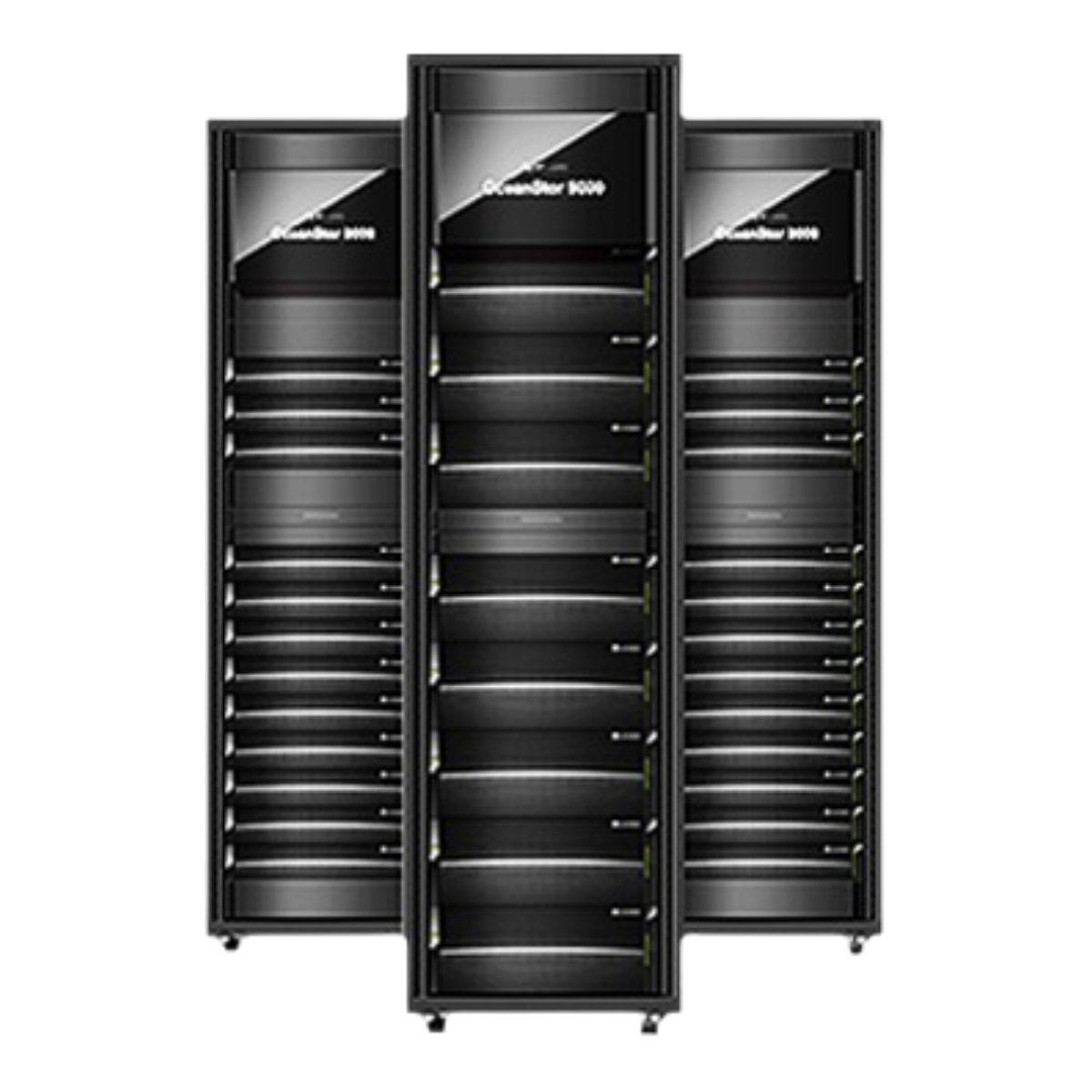OceanStor 9000 V5 provides advantages such as large capacity, high performance, and flexible scalability as well as a range of value-added features. It can be applied to various fields such as broadcasting, media, high-performance computing (HPC), Internet operation, data centers, and large-sized enterprises.
Condition: NOB
RMA Warranty
Description
Product Highlights
OceanStor 9000 V5 features outstanding performance, flexible scalability, openness and convergence, robust reliability, and simplified management, helping enterprises reduce the capital expenditure (CAPEX) and operating expenditure (OPEX).
Outstanding Performance
OceanStor 9000 V5 delivers industry-leading read/write performance that fully addresses the performance requirements of different fields such as media editing and HPC.
OceanStor 9000 V5 provides the following key technologies for file system applications:
- Concurrent access
Traditional NAS systems consist of engines and storage units. All concurrent access requests are processed by engines, which are likely to become performance bottlenecks.
OceanStor 9000 V5 employs a fully symmetric distributed architecture where each node can provide external service access. Based on the load balancing design, data access requests are evenly distributed to all nodes in the cluster, greatly improve the system concurrent access capability.
- Global cache
The read/write speed of data in cache is much higher than that on disks, but each node has limited cache space. If cache space on nodes is limited and independent from each other, it is difficult to increase the cache hit ratio and ensure data consistency.
OceanStor 9000 V5 provides the global cache mechanism to resolve these problems. A cache pool is provided to integrate the cache on all nodes. The cache pool stores only one copy of a file and is accessible to any node. The global cache mechanism elevates system performance and improves the data hit ratio while shortening the latency.
- High-speed node interconnection
OceanStor 9000 V5 supports 10GE high-speed networks. Each node provides four 10GE ports. OceanStor 9000 V5 also supports node interconnection over an InfiniBand (IB) network to meet more demanding performance requirements.
With high-speed node interconnection, OceanStor 9000 V5 meets different networking requirements and delivers lower internal latency and better performance.
- Solid state drive (SSD) acceleration and dynamic storage tiering (DST)
High-performance SSDs help eliminate read/write performance bottlenecks, lower latency, and increase throughput. OceanStor 9000 V5 can automatically identify hotspot data and small files, and migrate data between different storage tiers based on data access frequencies to improve resource utilization.
- SMB3 Multichannel
OceanStor 9000 V5 supports the SMB3 Multichannel function. By fully utilizing multi-core CPUs and bandwidth resources of clients, SMB3 Multichannel greatly improves service performance and reliability. In addition, if one channel fails, SMB3 Multichannel transmits data over another channel to prevent services from being affected.
- Rapid internal file replication
Internal file replication is rapidly implemented within OceanStor 9000 V5 without involving clients.
- NFS protocol enhancement
The traditional NFS protocol is limited by the bandwidth of a single network port and block size. A client supports a maximum bandwidth of 1 GB/s. OceanStor 9000 V5 enhances the NFS protocol. Multiple network ports and the NFS protocol plug-in DFSClient are configured on NFS clients for concurrent connections of multiple network ports and cache optimization to improve performance of the clients.
- Bandwidth of a Mac OS X client is 1.5 GB/s.
- Bandwidth of an RHEL client is 2.5 GB/s.
- Disk defragmentation
OceanStor 9000 V5 provides the disk defragmentation function. In a specified period of time, periodically executing disk defragmentation tasks ensures satisfactory system performance for a long time.
Flexible Scalability
With a distributed architecture, OceanStor 9000 V5 supports seamless scale-out of 3 to 288 nodes. All nodes are symmetrically arranged in OceanStor 9000 V5, and all data and metadata are evenly distributed on each node to eliminate system bottlenecks.
OceanStor 9000 V5 can be smoothly scaled out in line with service growth, enabling linear increase of capacity and performance. OceanStor 9000 V5 offers up to 100 PB capacity for a single file system to help minimize the CAPEX and OPEX, adapting to changing storage requirements.
OceanStor 9000 V5 provides the following node types to fit into different application scenarios:
- P12E/P12X/P12A, P25E/P25X/S25X, and P36E/P36X/P36A/C36A nodes are high-performance storage nodes. They are applied to OPS-intensive and high-bandwidth application scenarios.
- C36E or C36X is a large-capacity archiving node, which is used for large-capacity application scenarios.
Robust Reliability
OceanStor 9000 V5 employs a distributed cluster architecture where all components are fully redundant, eliminating single points of failure (SPOFs). Key components of storage nodes, such as fan modules, power modules, and port modules, adopt a redundant design to improve hardware reliability. The reliability design of OceanStor 9000 V5 also includes:
- N+M data protection level
Erasure Coding (EC) enables inter-node RAID function, ensuring data integrity of a node even when the node fails. Multiple protection levels are supported, such as N+1, N+2, N+3, N+4, N+2:1, and N+3:1. You can specify a protection level for any empty directory in a file system.
- Mirroring
Mirroring helps store multiple copies of metadata onto different storage nodes for improved data protection.
- Data reconstruction
Automatic node fault detection and automatic data recovery are supported. When a disk or node fails, data can be retrieved, preventing data loss upon node or disk failures.
- Physical domain division
Physical domain division is an efficient way to isolate faulty domains from functioning ones. When a disk or node in a domain (node pool or node pool group) fails, physical domain division ensures that reliability and security of data in other domains are not affected, so is the read/write performance of other domains during data recovery.
- Data consistency scanning
Data consistency scanning, also called data scrub, periodically checks data in the background without affecting services, thereby discovering disk errors in advance to prevent silent corruption from causing data loss.
OceanStor 9000 V5 also provides a variety of advanced data protection technologies that ensure data availability even in a catastrophe, thereby protecting service continuity.
- InfoReplicator: A remote replication feature. You can set an automatic replication cycle or manually start a data replication task to replicate specified directories or files from one storage system to other storage systems over IP links (either a LAN or a WAN). In this case, the disaster recovery (DR) capability is maximized.
- Network Data Management Protocol (NDMP): OceanStor DFS acts as a data source, and data is backed up to back up media such as tape libraries for data backup and recovery purposes.
- InfoStamper: A directory-level snapshot feature. You can create snapshots of any directory (except the root directory) in a file system to easily back up important data.
- InfoRevive: In video surveillance scenarios, if the number of failed nodes or disks exceeds the redundancy upper limit, a certain percentage of damaged video file data can still be read and data can be written to the damaged video files, thereby enhancing the availability, security, and continuity of system services.
Simplified Management
OceanStor 9000 V5 supports graphical automatic deployment, flexible space quotas, comprehensive performance monitoring, unified network topology management, and unified namespace. Management and maintenance are efficient, centralized, simple, and easy.
- Administrators can use DeviceManager to manage hardware, software, clusters, and services in a unified manner.
- OceanStor 9000 V5 adopts flexible quota space to dispatch storage resources for directories, users, and user groups.
- If multiple OceanStor 9000 V5 storage systems are used in application scenarios such as video surveillance and remote replication, eSight can be used to centrally manage and maintain these storage systems.
- SystemReporter, performance analysis tool of OceanStor 9000 V5, uses data collection, archiving, analysis, and prediction methods to provide real-time monitoring, historical trend analysis, comparison-based analysis, diagnostic analysis, and capacity prediction for you to better use resources.
- System software is automatically deployed and configured. One-click rapid capacity expansion is supported.
| Specifications | OceanStor 9000 V5 |
| System Architecture | Fully symmetric distributed architecture |
| Number of Nodes | 3 to 288 |
| System Features | Distributed file system that supports global namespace and can dynamically scale out up to 140 PB |
| Applications | Unstructured data storage |
| Front-end Network Types | 40 GE, 25 GE, 10 GE, GE, and InfiniBand |
| Internal Network Types | 25 GE, 10 GE, and InfiniBand |
| Data Protection Levels | N + 1, N + 2, N + 3, and N + 4 |
| Data Disk Types | SSD, SAS, SATA, and NL-SAS |
| Software |
|
| Data Recovery | Automatic, concurrent restoration at up to 2 TB/hr |
| Supported Protocols | NFS, CIFS, FTP, NIS, OpenStack Manila, Microsoft Active Directory, and LDAP |






Isaac (verified owner) –
Very well worth the money.